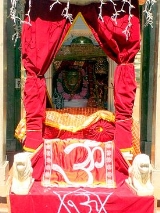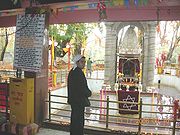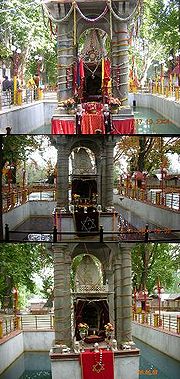
Kheer Bhawani
Encyclopedia
Kheer Bhawani is a temple dedicated to the Goddess Kheer Bhawani
(originally just Bhawani) constructed over a sacred spring .The worship of Kheer Bhawani is universal among the Hindu
s of Kashmir
. The temple is situated at a distance of 14 miles east of Srinagar
near the village of Tula Mula. The term kheer refers to rice pudding that is offered in the spring to propitiate the Goddess, which became part of the name of the temple. As is the custom with Hindu deities, she has many names: Maharagya Devi, Ragnya Devi, Rajni, Ragnya Bhagwati, and so on.

in Kashmir, known as the Kashmiri Pandits. Around the temple is an area covered with smooth and beautiful stones. In it are large, old-growth chinar
trees beneath which the pilgrims sit or sleep on mats of grass. While most of the colours do not have any particular significance, the colour of the spring water changes occasionally. When black or darkish, its believed to be an indication of inauspicious times for Kashmir. In 1886, Walter Lawrence, the-then British settlement commissioner for land, during his visit to the spring, reported the water of the spring to have a voilet tinge.
and appeared before him and Ravana got an image of the Goddess installed in Sri Lanka
. However, the Goddess became displeased with the vicious and licentious life of Ravana and so didn't want to stay in Sri Lanka. Therefore, she is believed to have instructed Lord Hanuman
to get the image from Sri Lanka and install it at the holy spot of Tula Mulla.
The mention of Kheer Bhawani is found in Kalhana
's Rajtarangini. Kalhana writes that the sacred spring of Tula Mula is situated in a marshy ground. The name of the spring is Mata Ragini Kund (pond).
Maharagini is the form of Durga
Bhagvati. The brahmins of Kashmir worship this spring and pilgrims from every comer of the country visit to have the darshan of the place.
In Rajtarangini, Tula Mula and the spring of Maharagya has been considered very sacred and the brahmins of Tula Mula considered notable for their spiritual prowess. Thousands of years ago, many floods occurred in Kashmir and the sacred spring of Tula Mula was inundated under its sway and the holy place could nowhere be traced. At last, Kashmir's Yogi Krishna Pandit had a dream in which the Goddess appeared to him and directed that she would swim in the form of a snake at the proper place and that he should stick large poles to demarcate the holy spot in the marsh land. Subsequently, when the water subsided there the holy spot was discovered. This event happened during the Samvat 4041 (Hindu lunar date).
Abul-Fazal in his book Aini-Akbari mentions the area of Tula Mula extending over a region of hundred bighas (unit of land area) of land, which used to sink in the marshy lands during the summer season.
Swami Rama Tirtha
and Swami Vivekananda
also visited here to have the darshan of the place.
 In the past, with incessant offerring of milk and sugar candy in the spring by pilgrims, a thick layer of offerings had accumulated at its base. When it was cleared, the ruins of an old temple and shrine slabs engraved with figures were discovered. Here many images were also found but nobody rebuilt the temple till the Samvat 1969 (Hindu lunar date) when Maharaja Pratap Singh who was the disciple of the Goddess, got a temple of marble made in the midst of the spring which shines like a pearl in a shell. The marble temple was completed in 1920s.
In the past, with incessant offerring of milk and sugar candy in the spring by pilgrims, a thick layer of offerings had accumulated at its base. When it was cleared, the ruins of an old temple and shrine slabs engraved with figures were discovered. Here many images were also found but nobody rebuilt the temple till the Samvat 1969 (Hindu lunar date) when Maharaja Pratap Singh who was the disciple of the Goddess, got a temple of marble made in the midst of the spring which shines like a pearl in a shell. The marble temple was completed in 1920s.
Some people are of the opinion that there was a mulberry tree near holy spot of Kheer Bhawani which, in local language, is called tul mul. But tul mul is also derived from the Sanskrit word atulya mulya meaning great value. It is believed that Ravana, after his worship of the Goddess, offered her kheer (rice pudding), which she accepted and since then it is called Kheer Bhawani.
, is believed to have been a grahasta (house-holder) saint of tall order and as such his peers would call him Jada Bharata, who was a legendary saint of Puranas
times. He used to live in Sekidafer area of Srinagar
in Kashmir
. He was married but didn't have any children so he is said to have finally adopted a son named Madhav Joo. He would regularly meditate at this holy spring and during one such occasion, while being in a meditative trance (samadhi
), he is said to have had a vision of the deity of Mata Kheer Bhawani, who reprimanded him for his hasty decision of going for an adoption when she was herself desirous of taking birth in his family as his daughter. Nonetheless, she is said to have blessed him with the boon and eventually Pandit Prasad Joo Parimoo's wife did give birth to a daughter, who was named Haar Maal. Approximate year of her birth would be 1870-1880 (see notes). In the course of time, Smt Haar Maal got married to Pandit Narayan Joo Bhan and gave birth to a son in 1898 who later came to be called Bhagwan Gopinath during his life-time.
 A unique septagonal spring dedicated to Goddess Kheir Bhawani flows from west(sheer or head section) to the east(padh or feet). The holy spring is known to change its colour with various hues of red, pink, orange, green, blue, white, etc. which was noted by Abul Fazal and Swami Vivekananda
A unique septagonal spring dedicated to Goddess Kheir Bhawani flows from west(sheer or head section) to the east(padh or feet). The holy spring is known to change its colour with various hues of red, pink, orange, green, blue, white, etc. which was noted by Abul Fazal and Swami Vivekananda
. A black shade of the spring water is believed to be inauspicious.
, who is the trustee of the Dharmarth Trust that looks after the affairs of this shrine and many other pandit-shrines of Kashmir, refused to carry this proposal forward. He believed that the native Kashmiri Pandit
community, in general, won't be happy with the change of the look of the old structure.
Bhawani
Bhawani is a village development committee in Dailekh District in the Bheri Zone of western-central Nepal. At the time of the 1991 Nepal census it had a population of 1421 people living in 269 individual households.-External links:*...
(originally just Bhawani) constructed over a sacred spring .The worship of Kheer Bhawani is universal among the Hindu
Hindu
Hindu refers to an identity associated with the philosophical, religious and cultural systems that are indigenous to the Indian subcontinent. As used in the Constitution of India, the word "Hindu" is also attributed to all persons professing any Indian religion...
s of Kashmir
Kashmir
Kashmir is the northwestern region of the Indian subcontinent. Until the mid-19th century, the term Kashmir geographically denoted only the valley between the Great Himalayas and the Pir Panjal mountain range...
. The temple is situated at a distance of 14 miles east of Srinagar
Srinagar
Srinagar is the summer seasonal capital of Jammu and Kashmir. It is situated in Kashmir Valley and lies on the banks of the Jhelum River, a tributary of the Indus. It is one of the largest cities in India not to have a Hindu majority. The city is famous for its gardens, lakes and houseboats...
near the village of Tula Mula. The term kheer refers to rice pudding that is offered in the spring to propitiate the Goddess, which became part of the name of the temple. As is the custom with Hindu deities, she has many names: Maharagya Devi, Ragnya Devi, Rajni, Ragnya Bhagwati, and so on.

Temple description
It is the most important temple for the followers of Historical Vedic ReligionHistorical Vedic religion
The religion of the Vedic period is a historical predecessor of Hinduism. Its liturgy is reflected in the mantra portion of the four Vedas, which are compiled in Sanskrit. The religious practices centered on a clergy administering rites...
in Kashmir, known as the Kashmiri Pandits. Around the temple is an area covered with smooth and beautiful stones. In it are large, old-growth chinar
Platanus orientalis
Platanus orientalis, or the Oriental plane, is a large, deciduous tree of the Platanaceae family, known for its longevity and spreading crown. The species name derives from its historical distribution eastward from the Balkans, where it was recognized in ancient Greek history and literature....
trees beneath which the pilgrims sit or sleep on mats of grass. While most of the colours do not have any particular significance, the colour of the spring water changes occasionally. When black or darkish, its believed to be an indication of inauspicious times for Kashmir. In 1886, Walter Lawrence, the-then British settlement commissioner for land, during his visit to the spring, reported the water of the spring to have a voilet tinge.
History
Maharagya was pleased with the devotion of RavanaRavana
' is the primary antagonist character of the Hindu legend, the Ramayana; who is the great king of Lanka. In the classic text, he is mainly depicted negatively, kidnapping Rama's wife Sita, to claim vengeance on Rama and his brother Lakshmana for having cut off the nose of his sister...
and appeared before him and Ravana got an image of the Goddess installed in Sri Lanka
Sri Lanka
Sri Lanka, officially the Democratic Socialist Republic of Sri Lanka is a country off the southern coast of the Indian subcontinent. Known until 1972 as Ceylon , Sri Lanka is an island surrounded by the Indian Ocean, the Gulf of Mannar and the Palk Strait, and lies in the vicinity of India and the...
. However, the Goddess became displeased with the vicious and licentious life of Ravana and so didn't want to stay in Sri Lanka. Therefore, she is believed to have instructed Lord Hanuman
Hanuman
Hanuman , is a Hindu deity, who is an ardent devotee of Rama, a central character in the Indian epic Ramayana and one of the dearest devotees of lord Rama. A general among the vanaras, an ape-like race of forest-dwellers, Hanuman is an incarnation of the divine and a disciple of Lord Rama in the...
to get the image from Sri Lanka and install it at the holy spot of Tula Mulla.
The mention of Kheer Bhawani is found in Kalhana
Kalhana
Kalhana , a Kashmiri, was the author of Rajatarangini , an account of the history of Kashmir. He wrote the work in Sanskrit between 1148 and 1149. All information regarding his life has to be deduced from his own writing, a major scholar of which is Mark Aurel Stein...
's Rajtarangini. Kalhana writes that the sacred spring of Tula Mula is situated in a marshy ground. The name of the spring is Mata Ragini Kund (pond).
Maharagini is the form of Durga
Durga
For the 1985 Hindi Film of Rajesh Khanna see DurgaaIn Hinduism, Durga ; ; meaning "the inaccessible" or "the invincible"; , durga) or Maa Durga "one who can redeem in situations of utmost distress" is a form of Devi, the supremely radiant goddess, depicted as having eighteen arms, riding a lion...
Bhagvati. The brahmins of Kashmir worship this spring and pilgrims from every comer of the country visit to have the darshan of the place.
In Rajtarangini, Tula Mula and the spring of Maharagya has been considered very sacred and the brahmins of Tula Mula considered notable for their spiritual prowess. Thousands of years ago, many floods occurred in Kashmir and the sacred spring of Tula Mula was inundated under its sway and the holy place could nowhere be traced. At last, Kashmir's Yogi Krishna Pandit had a dream in which the Goddess appeared to him and directed that she would swim in the form of a snake at the proper place and that he should stick large poles to demarcate the holy spot in the marsh land. Subsequently, when the water subsided there the holy spot was discovered. This event happened during the Samvat 4041 (Hindu lunar date).
Abul-Fazal in his book Aini-Akbari mentions the area of Tula Mula extending over a region of hundred bighas (unit of land area) of land, which used to sink in the marshy lands during the summer season.
Swami Rama Tirtha
Swami Rama Tirtha
Swami Ram Tirth , also known as Swami Ram, was an Indian teacher of the Hindu philosophy of Vedanta. He was among the first notable teachers of Hinduism to lecture in the United States, traveling there in 1902. He was preceded by Swami Vivekananda in 1893, and followed by Paramahansa Yogananda in...
and Swami Vivekananda
Swami Vivekananda
Swami Vivekananda , born Narendranath Dutta , was the chief disciple of the 19th century mystic Ramakrishna Paramahansa and the founder of the Ramakrishna Math and the Ramakrishna Mission...
also visited here to have the darshan of the place.

Some people are of the opinion that there was a mulberry tree near holy spot of Kheer Bhawani which, in local language, is called tul mul. But tul mul is also derived from the Sanskrit word atulya mulya meaning great value. It is believed that Ravana, after his worship of the Goddess, offered her kheer (rice pudding), which she accepted and since then it is called Kheer Bhawani.
Birth of Goddess in human form
Pandit Prasad Joo Parimoo, a Kashmiri panditKashmiri Pandit
The Kashmiri Pandits are a Hindu Brahmin community originating from Kashmir, a mountainous region in South Asia.-Background:The Hindu caste system of the region was influenced by the influx of Buddhism from the time of Asoka, around the third century BCE, and a consequence of this was that the...
, is believed to have been a grahasta (house-holder) saint of tall order and as such his peers would call him Jada Bharata, who was a legendary saint of Puranas
Puranas
The Puranas are a genre of important Hindu, Jain and Buddhist religious texts, notably consisting of narratives of the history of the universe from creation to destruction, genealogies of kings, heroes, sages, and demigods, and descriptions of Hindu cosmology, philosophy, and geography.Puranas...
times. He used to live in Sekidafer area of Srinagar
Srinagar
Srinagar is the summer seasonal capital of Jammu and Kashmir. It is situated in Kashmir Valley and lies on the banks of the Jhelum River, a tributary of the Indus. It is one of the largest cities in India not to have a Hindu majority. The city is famous for its gardens, lakes and houseboats...
in Kashmir
Kashmir
Kashmir is the northwestern region of the Indian subcontinent. Until the mid-19th century, the term Kashmir geographically denoted only the valley between the Great Himalayas and the Pir Panjal mountain range...
. He was married but didn't have any children so he is said to have finally adopted a son named Madhav Joo. He would regularly meditate at this holy spring and during one such occasion, while being in a meditative trance (samadhi
Samadhi
Samadhi in Hinduism, Buddhism,Jainism, Sikhism and yogic schools is a higher level of concentrated meditation, or dhyāna. In the yoga tradition, it is the eighth and final limb identified in the Yoga Sūtras of Patañjali....
), he is said to have had a vision of the deity of Mata Kheer Bhawani, who reprimanded him for his hasty decision of going for an adoption when she was herself desirous of taking birth in his family as his daughter. Nonetheless, she is said to have blessed him with the boon and eventually Pandit Prasad Joo Parimoo's wife did give birth to a daughter, who was named Haar Maal. Approximate year of her birth would be 1870-1880 (see notes). In the course of time, Smt Haar Maal got married to Pandit Narayan Joo Bhan and gave birth to a son in 1898 who later came to be called Bhagwan Gopinath during his life-time.
Sacred spring

Swami Vivekananda
Swami Vivekananda , born Narendranath Dutta , was the chief disciple of the 19th century mystic Ramakrishna Paramahansa and the founder of the Ramakrishna Math and the Ramakrishna Mission...
. A black shade of the spring water is believed to be inauspicious.
Proposed new look
In early 2008, there were plans to modify the basic design of the marble structure. The project was sponsored by Capt. Kapil Raina and family. However, Dr. Karan SinghKaran Singh
Karan Singh is an MP in the Rajya Sabha, a senior member of the ruling Indian National Congress Party serving as Chairman of the Foreign Affairs Department, President of the Indian Council for Cultural Relations , India's Ambassador to UNESCO, Chairman of the Auroville Foundation and of the Temple...
, who is the trustee of the Dharmarth Trust that looks after the affairs of this shrine and many other pandit-shrines of Kashmir, refused to carry this proposal forward. He believed that the native Kashmiri Pandit
Kashmiri Pandit
The Kashmiri Pandits are a Hindu Brahmin community originating from Kashmir, a mountainous region in South Asia.-Background:The Hindu caste system of the region was influenced by the influx of Buddhism from the time of Asoka, around the third century BCE, and a consequence of this was that the...
community, in general, won't be happy with the change of the look of the old structure.

